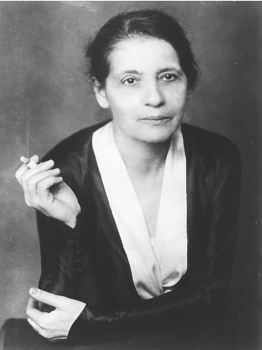

Lise Meitner, 1937 |
She emigrated to Berlin in September 1907 and remained there until she was forced out by the Nazis as they enforced their racial laws (she was Jewish). She crossed the border from Germany to Holland on July 13, 1938 and ultimately settled in Sweden where, with considerable difficulty, she had obtained a position at the Nobel Institute for Theoretical Physics.
Lise Meitner is famous as the co-discoverer of nuclear fission with the German chemist Otto Hahn with whom she collaborated, beginning in 1913, while she was at the Kaiser Wilhelm Institute in Dahlem, a suburb of Berlin. Their first work was in identifying the elements in radioactive decay series. The experiments which led to the discovery of nuclear fission involved the study of the decay products of uranium irradiated with neutrons.
It was an article of faith at the time that the number of nucleons in the decay product had to be close to that of the parent. Due to the difficulty of the chemical separations involved, this prejudice, and the fact that Meitner was by then in exile in Sweden, the significance of barium among the decay products, which would have implied fission, was at first misunderstood.
On December 19, 1938, Hahn communicated his latest experimental results to Meitner in a letter. On December 23, she and her nephew Otto Robert Frisch, a physicist at Niels Bohr's institute in Copenhagen, were at the home of Swedish friends for the Christmas holidays. Meitner had Hahn's letter with her.
During a walk in the snow, with Frisch on skis, the two began discussing Hahn's latest results. In the course of this discussion, Meitner realized that Hahn's observation of barium could be explained by fission of the irradiated uranium using Bohr's liquid drop model of the parent nucleus. The energy of the daughter particles was perfectly accounted for by the defect in their combined mass relative to the parent using Einstein's relationship, E = mc2.
After the holidays, Frisch discussed his conversation with Meitner with Bohr. Bohr left Copenhagen for New York on January 7, 1939 accompanied by a colleague, Leon Rosenfeld with whom he discussed the Frisch-Meitner results in his cabin aboard ship. Bohr had promised Frisch not to discuss their findings until their paper appeared, but failed to inform Rosenfeld of his promise. Rosenfeld went to Princeton upon their arrival in New York to attend a seminar and freely discussed the discovery of fission. Work immediately began at laboratories in the US to confirm the results.
The Times' reference to Meitner "holding one of the keys to the mystery" is misleading because by the time the US began developing the atomic bomb, the physics of fission was well understood, partly because Meitner and Frisch, and Hahn and Strassman, respectively, had published theoretical and experimental papers on their work in late 1938 and early 1939 and partly because their work was taken up and carried forward in US university laboratories. If we date the beginning of the Manhattan Project from the date General Leslie Groves was assigned to it, September 17, 1942, Meitner's discovery of nuclear fission was already 3½ years old. And relative to Enrico Fermi's experminental demonstration of a chain reaction on Dec 2, 1942, it was almost four years old.
My principle reference for these notes is, "Lise Meitner: A Life in Physics," Ruth Lewin Sime, The University of California Press, Berkeley and Los Angeles, 1996.